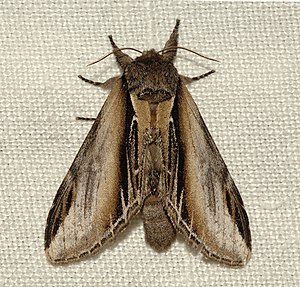Poplar Toothed Moth
| Poplar Toothed Moth | ||||||||||||
|---|---|---|---|---|---|---|---|---|---|---|---|---|

Poplar toothed moth ( Pheosia tremula ) |
||||||||||||
| Systematics | ||||||||||||
|
||||||||||||
| Scientific name | ||||||||||||
| Pheosia tremula | ||||||||||||
| ( Clerck , 1759) |
The poplar toothed spinner or aspen porcelain spinner ( Pheosia tremula ) is a butterfly ( moth ) from the family of toothed moth (Notodontidae).
features
The moths reach a wingspan of 46 to 56 millimeters. As is so often the case with butterflies, the females are larger than the males. The name of this species comes from the porcelain-colored shimmer of the wings. The porcelain moth is very similar to the birch toothed moth ( Pheosia gnoma ), but this shows a white wedge spot on the rear edge of the forewing.
Similar species
- Birch toothed moth ( Pheosia gnoma ) (Fabricius, 1776)
habitat
The poplar toothed moth is only found where there are also poplars , i.e. in alluvial forests, parks, mixed forests, moors and on flowing water, as poplars need a lot of water. The distribution area extends across Europe and in the north to the Arctic Circle . In the Alps you can find the animals up to an altitude of 1,600 meters. The planting of poplar monocultures has led to mass reproductions of this species more frequently in recent years, which, however, have never caused much damage.
development
In favorable years there are two generations. The nocturnal moths of the first generation can be found from late April to mid-June and the associated caterpillars from September to early October. The second generation moths fly from mid-July to mid-August and spend their caterpillar life from June to July. Both generations can shift into one another. The caterpillars are smooth and yellow with green or brown markings. To pupate, the caterpillars dig into the soft ground using shaking movements.
Food of the caterpillars
The forage plants mainly include the various types of poplar, but the leaves of willow and birch are also eaten.
swell
literature
- Günter Ebert: The Butterflies of Baden-Württemberg Volume 4, Moths II (Bombycidae, Endromidae, Lemoniidae, Saturniidae, Sphingidae, Drepanidae, Notodontidae, Dilobidae, Lymantriidae, Ctenuchidae, Nolidae). Ulmer Verlag Stuttgart 1994. ISBN 3-800-13474-8
Web links
- www.lepiforum.de
- www.schmetterling-raupe.de
- Pheosia tremula in Fauna Europaea
- Moths and Butterflies aof Europe and North Africa (English)
- Markku Savela: Lepidoptera and some other Lifeforms (English)